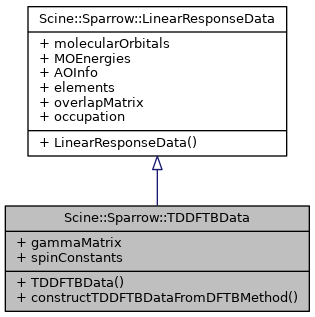|
Scine::Sparrow
5.0.0
Library for fast and agile quantum chemical calculations with semiempirical methods.
|
|
Scine::Sparrow
5.0.0
Library for fast and agile quantum chemical calculations with semiempirical methods.
|
This class contains the infos needed to perform a TD-DFTB calculation. This way excited states properties can be calculated in a LR-TD approach. The data are given by reference to prevent useless copies. Right now the data needed to perform TD-SCC-DFTB are present. In order to implement TD-DFTB3 other data might be needed. More...
#include <TDDFTBData.h>


Public Member Functions | |
| TDDFTBData (const Utils::MolecularOrbitals &MOs, const Utils::SingleParticleEnergies &orbitalEnergies, Utils::AtomsOrbitalsIndexes aoIndex, const Utils::ElementTypeCollection &elements, const Utils::LcaoUtils::ElectronicOccupation &occupation, const Eigen::MatrixXd &overlapMatrix, const Eigen::MatrixXd &gMatrix, std::shared_ptr< Eigen::VectorXd > spinConstantVector) | |
 Public Member Functions inherited from Scine::Sparrow::LinearResponseData Public Member Functions inherited from Scine::Sparrow::LinearResponseData | |
| LinearResponseData (const Utils::MolecularOrbitals &MOs, const Utils::SingleParticleEnergies &orbitalEnergies, Utils::AtomsOrbitalsIndexes aoIndex, const Utils::ElementTypeCollection &elements, const Utils::LcaoUtils::ElectronicOccupation &occupation, const Eigen::MatrixXd &overlapMatrix) | |
Static Public Member Functions | |
| template<class DFTBMethod > | |
| static TDDFTBData | constructTDDFTBDataFromDFTBMethod (const DFTBMethod &method) |
Public Attributes | |
| std::shared_ptr< Eigen::MatrixXd > | gammaMatrix |
| Gamma parameters size: nAtoms x nAtoms. | |
| std::shared_ptr< Eigen::VectorXd > | spinConstants |
| Magnetic Hubbard parameters (spin constants) size: nAtoms. | |
 Public Attributes inherited from Scine::Sparrow::LinearResponseData Public Attributes inherited from Scine::Sparrow::LinearResponseData | |
| const Utils::MolecularOrbitals & | molecularOrbitals |
|
const Utils::SingleParticleEnergies & | MOEnergies |
| const Utils::AtomsOrbitalsIndexes | AOInfo |
|
const Utils::ElementTypeCollection & | elements |
| const Eigen::MatrixXd & | overlapMatrix |
|
const Utils::LcaoUtils::ElectronicOccupation & | occupation |
This class contains the infos needed to perform a TD-DFTB calculation. This way excited states properties can be calculated in a LR-TD approach. The data are given by reference to prevent useless copies. Right now the data needed to perform TD-SCC-DFTB are present. In order to implement TD-DFTB3 other data might be needed.